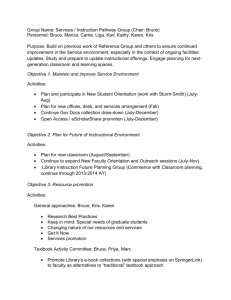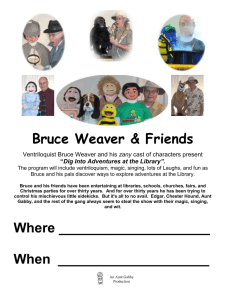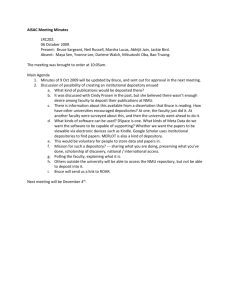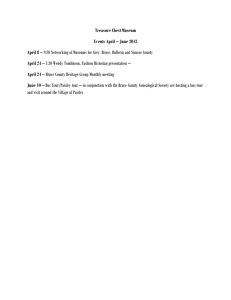Christopher bruce
advertisement
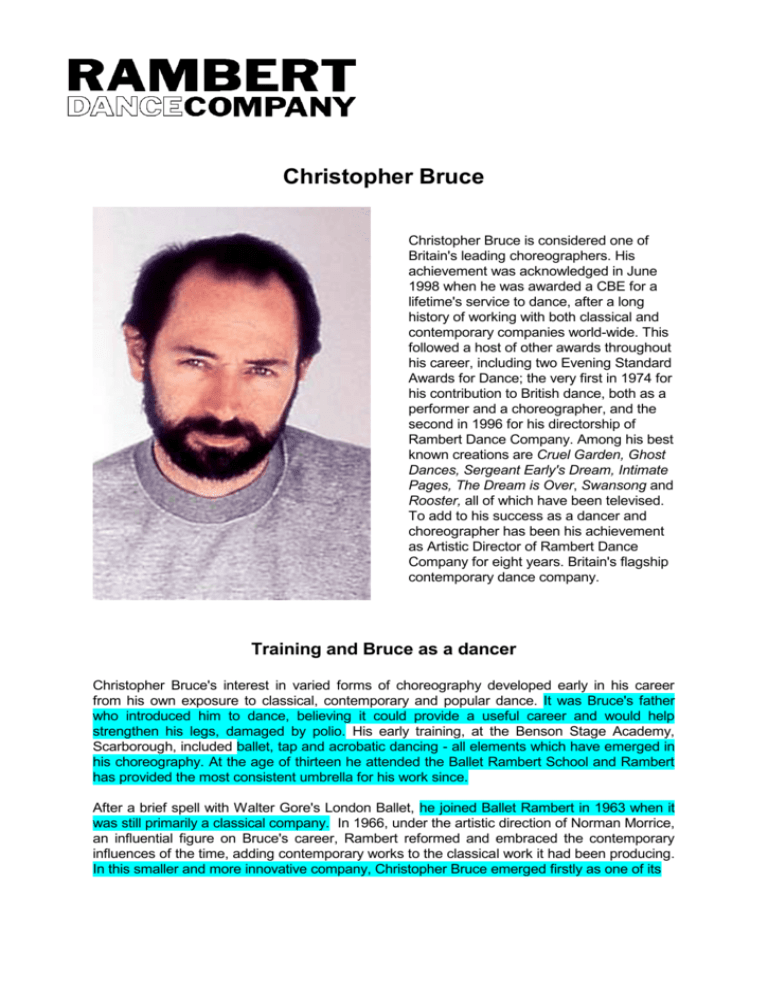
Christopher Bruce Christopher Bruce is considered one of Britain's leading choreographers. His achievement was acknowledged in June 1998 when he was awarded a CBE for a lifetime's service to dance, after a long history of working with both classical and contemporary companies world-wide. This followed a host of other awards throughout his career, including two Evening Standard Awards for Dance; the very first in 1974 for his contribution to British dance, both as a performer and a choreographer, and the second in 1996 for his directorship of Rambert Dance Company. Among his best known creations are Cruel Garden, Ghost Dances, Sergeant Early's Dream, Intimate Pages, The Dream is Over, Swansong and Rooster, all of which have been televised. To add to his success as a dancer and choreographer has been his achievement as Artistic Director of Rambert Dance Company for eight years. Britain's flagship contemporary dance company. Training and Bruce as a dancer Christopher Bruce's interest in varied forms of choreography developed early in his career from his own exposure to classical, contemporary and popular dance. It was Bruce's father who introduced him to dance, believing it could provide a useful career and would help strengthen his legs, damaged by polio. His early training, at the Benson Stage Academy, Scarborough, included ballet, tap and acrobatic dancing - all elements which have emerged in his choreography. At the age of thirteen he attended the Ballet Rambert School and Rambert has provided the most consistent umbrella for his work since. After a brief spell with Walter Gore's London Ballet, he joined Ballet Rambert in 1963 when it was still primarily a classical company. In 1966, under the artistic direction of Norman Morrice, an influential figure on Bruce's career, Rambert reformed and embraced the contemporary influences of the time, adding contemporary works to the classical work it had been producing. In this smaller and more innovative company, Christopher Bruce emerged firstly as one of its leading dancers and, a few years later, as one of its major choreographers - the last to be nurtured by the Company's founder, Marie Rambert. As a dancer, Bruce was recognised as an artist of intense dramatic power and was considered to be one of the best male interpreters of modern dance in Britain. This was revealed in the title roles in Glen Tetley's Pierrot Lunaire, Vaslav Nijinsky's l'Après-midi d'un faune and the poet in his own work Cruel Garden. Christopher Bruce's performing career was largely with Ballet Rambert, with occasional guest performances for other companies. Bruce took on his last major role in 1988, when he was becoming increasingly in demand as a freelance choreographer. A few months after choreographing Swansong (1987) he performed the puppet Petrouchka in Michel Fokine's ballet for London Festival Ballet, but scheduling only allowed him one performance. Pierrot Lunaire © Anthony Crickmay Bruce as a Choreographer As a choreographer the variety and experimentation of Ballet Rambert in the 1960s undoubtedly stimulated Christopher Bruce. His experiences with Walter Gore and Marie Rambert exposed him to the use of narrative and character in dance and to the understated yet universal drama of Antony Tudor's choreography, created in the 1930s and still performed by Rambert. After 1966 he began to experience Graham technique as taught in Britain, and the opportunity to work with Glen Tetley, whose choreographic language synthesises elements of both classical and contemporary dance, was telling on the development of Bruce's own movement vocabulary. Other influences on Bruce's work (more in terms of approach than specific style) include Norman Morrice, whose choreography moved away from specific dramas to universal themes, Anna Sokolow (an American guest choreographer in 1967 and 1970), who produced both socially aware drama and productions to popular music and Marie Rambert who instilled high standards in Bruce and emphasised the need for theatricality in dance. Bruce created his first work George Frideric in 1969 for Ballet Rambert and created a further twenty works for the Company between then and the end of the 1970s. Between 1975 and 1987, he was first Associate Director and then, as he was increasingly in demand internationally as a choreographer, Associate Choreographer for Rambert before returning as Artistic Director in 1994. Although Rambert has been Bruce's `home base' for most of his career, he is in great demand to create and revive productions for companies worldwide. Swansong was Bruce's most successful creation for London Festival Ballet (now English National Ballet) a company he first worked with when he created Land in 1985. In April 1986 he was appointed London Festival Ballet's Associate Choreographer by Artistic Director Peter Schaufuss, a position he held until 1991. Bruce has also developed special relationships with a number of international companies including Australian Dance Theatre, Nederlands Dans Theater, Royal Danish Ballet, Cullberg Ballet, Gulbenkian Ballet, Ballet du Grand Theatre de Geneve and Houston Ballet (where having been Resident Choreographer from 1989 - 1998, he is now Associate Choreographer). In addition, Bruce has choreographed for a wide range of operas and theatrical productions. These have included; plays for the Royal Shakespeare Company and Royal National Theatre (where he collaborated with composer Dominic Muldowney) and musicals’, including the original production of Andrew Lloyd-Webber’s Joseph and the Amazing Technicolour Dreamcoat and David Essex's Mutiny. During his time as Artistic Director for Rambert Dance Company (1994-2002), he created nine new works for the Company. Crossing (1994) was created for the Company's relaunch season and followed by Meeting Point (1995) which was created to celebrate the 50th anniversary of the signing of the United Nations Charter, and was premiered at "United We Dance: An International Festival" which took place in San Francisco in May 1995. Bruce created Quicksilver (1996) to commemorate the Company's 70th Anniversary and Stream (1996). Bruce's next work Four Scenes (1998) was commissioned by Sadler's Wells, which Rambert presented to re-open the redeveloped theatre in October 1998. Bruce created a full-length evening production, God’s Plenty (1999) with composer Dominic Muldowney. The work is a theatrical pageant, which draws its inspiration from a wealth of medieval sources, including Chaucer's The Canterbury Tales. Bruce’s recent works for the company included Hurricane (2000), which had its London premiere in May 2001. This dramatic work is performed as a solo to Bob Dylan’s song of the same title and tells the story of Reuben ‘Hurricane’ Carter, a black American boxer who was wrongfully imprisoned for murder. Bruce’s latest creation for The Company is Grinning in Your Face (2001). This work was influenced by the folk and blues music of acoustic guitarist and vocalist Martin Simpson. Images of the American midwest during the middle decades of the last century inspired this particular work. The ballet is laced with the emotional power and lyrical beauty that are hallmarks of Bruce’s work. Hurricane ©Chris Nash Themes Christopher Bruce maintains that his ballets are essentially about ideas. They may not have an obvious story-line and may be episodic in structure, sometimes with parallel layers of narrative, but they generally include dramatic or emotive elements that make an impact on the audience. Even when his dances focus on movement and respond to music, as in Symphony in Three Movements (1989) and Stream, imagery is strong. While his works portray recognisable experiences they are deliberately open to multiple interpretations and he leaves his audience thinking about their experience and free to interpret what they have seen. Indeed, Bruce prefers them to watch unencumbered by lengthy programme notes or preconceived ideas - the very titles (Land, Waiting, Journey, Crossing, and Meeting Point) leave their subjects without specific boundaries. Bruce's work generally develops from an external stimulus - music, paintings or literature (fact, fiction, journalism, prose, poetry or history). Bruce, nevertheless, selects themes which may be conveyed through dance rather than transferring a complete work from one medium to another. Biographies, for example, have provided a rich vein of inspiration. The Dream is Over (1986) for Cullberg Ballet began life as danced interludes in a television documentary on John Lennon, Journey (1990) paid homage to dancer Erik Bruhn and Cruel Garden (1977) is a collage of the life and art of Federico Garcia Lorca. Cruel Garden was an important work for Bruce, not only because it was his first full-length production, but also because he worked collaboratively with mime artist Lindsay Kemp and composer Carlos Miranda. The result of this collaboration was a work which used the skills and ideas of all three artists involved to create a piece which evoked the life and experiences of Lorca by meshing dance with theatre, music, song and poetry. Cruel Garden was widely considered a landmark work in the history of dance theatre, and it was received with great acclaim when it was first created in 1977 and when it was revived by Rambert Dance Company in 1998, having been unseen on the British stage for a decade. Bruce's work also often contains an autobiographical element. Weekend (1974) reflected the stress placed on a marriage by constant touring; Rooster (1991) the lifestyle he remembered from the 1960s. A number of works, particularly those choreographed while his own family was growing up, such as Ancient Voices of Children (1975), reflect his love of children and his creation for the 1998 re-opening of Sadler's Wells, Four Scenes, continues this family theme now he is a grandfather. There is an unusual level of political, social and ecological awareness in Bruce's choice of subject. for these who die as cattle (1972) and Land (1985) evoke the horrors and devastating effects of war; Ghost Dances (1981), Silence is the End of our Song (1983) and Swansong are concerned with political oppression; Nature Dances (1992) and Stream reflect his response to nature. Characteristics of Style Bruce has a distinct choreographic style, which embraces both a classical and contemporary movement vocabulary. The style draws on both his ballet and Graham technique training and he uses the long extended lines of ballet but with off-balance tilts and attitudes. Balletic movements such as arabesques, attitudes and jetes combine with the low centre of gravity, a spiralling torso and use of off-balance from contemporary dance. He makes use of weight and the floor in deep plies and lunges. The phrasing and dynamics of Bruce's choreography are quite distinct. Stillness contrasts with fluid action as his movement runs away before being caught in an attitude or controlled offbalance. Like a sentence punctuated with commas and ending with a full stop, Bruce's phrasing gives his choreography a strong dynamic quality, with a distinct starting point, progression and finish within each phrase. Similarly simplicity and stillness juxtaposed with intricate footwork and fast-paced action are evident in his work. Bruce uses motif repetition and accumulation in his work where he revisits previous scenes as a device for impressing a theme or idea on the viewer. For example in `Sympathy for the Devil', the last section of dance in Rooster, the dancers re-live highlights from the seven previous scenes in the ballet. Similarly in the final victim solo in Swansong, as the victim draws slowly towards his exit, he re-lives images and motifs from his long interrogation. Bruce uses this device to remind the audience of the action that has taken place and the journey both they and the dancer have undertaken. Bruce also uses this symbolic repetition to shape the structure of many of his works, where specific scenes or images both open and close a work, reinforcing the idea that a story has been told or a journey has been undertaken. For example Ghost Dances opens and closes with the three ghost figures standing in suspended motion, similarly the opening and closing scenes are closely linked in Sergeant Early's Dream (1984) with the characters looking wistfully beyond the horizon as they reflect on their experiences. Ghost Dances © Anthony Crickmay Bruce demands his dancers to have a strong sense of musicality and characterisation and places importance on the personal interpretation of a role by a dancer. For example the role of the victim in Swansong, and also the four distinct characters in Moonshine (1993), created originally for older dancers where much of the dance is simple in structure and not overcomplex choreographically, leaving the dancers room to add their own interpretation to the work. Bruce's movement vocabulary incorporates the impressions of popular and folk dance where appropriate to give his choreography universality. Folk elements can be seen in Sergeant Early's Dream and Ghost Dances, in Quicksilver where the dancers perform a highland fling. Bruce introduces these elements of folk dancing without allowing himself to become to choreographically inhibited by too strict an adherence to traditional technique. Other dance styles Bruce has used include tap sequences in the interrogation scenes in Swansong and flamenco styles in Cruel Garden. Bruce is keen to highlight that he aims to give an essence of these styles rather than reproducing them authentically. Indeed, it is his intention to create the feel of a particular style whilst incorporating the greater movement possibilities of contemporary dance techniques. Bruce also uses recognisable everyday gesture and movement in his work. Pedestrian movement can be seen evolving into dance, for example in the rooster `struts' and `headpecks' performed by the arrogant male characters in Rooster. More recently in Four Scenes, movements from the children's game `hopscotch' become a motif for the dancers who portray children. Rooster ©Anthony Crickmay Music and Design It was the strong ideas of Marie Rambert who, in the short-term, influenced his belief that dance should be independent of music. Indeed for many of his early works, including Duets (1973), Weekend (1974) and There was a Time (1973) the electronic score was added when the choreography was almost complete. Bruce became more confident in using existing music, selecting compositions by George Crumb, Igor Stravinsky, Leos Janacek and Michael Nyman and commissioning original works from Philip Chambon. Since the early 1980s Bruce has also choreographed to popular songs by Billie Holiday, Joan Baez, John Lennon, the Rolling Stones and Bob Dylan. Bruce has collaborated closely with designers. Nadine Baylis designed many of his early creations and he has worked frequently with Pamela Marre, Walter Nobbe and his wife Marian Bruce. Pioneering stage designer Ralph Koltai provided the elaborate bullring set for Cruel Garden and Bruce has recently worked with emerging young designer Es Devlin on Four Scenes. On occasion, however, Bruce himself has taken the responsibility for the visual aspects of his productions notably Swansong and he created the Andean setting for Ghost Dances. Swansong ©Anthony Crickmay Bruce as Artistic Director Christopher Bruce had a strong artistic vision for Britain's flagship contemporary dance company throughout the eight years that he was Artistic Director. Rambert continues to tour extensively throughout the United Kingdom, giving approximately 80 performances in 15 different venues each year. In addition, the Company undertakes substantial overseas touring including recent visits to Korea, China, Ukraine, Mexico, America and New Zealand as well as performances in Europe. When the Company had its relaunch in 1994, it was Bruce's intention to develop a Company that demonstrated Rambert's heritage and ongoing creativity. Bruce's programming reflected this through the selection of contemporary dance that was and still is unique in its range. Rambert still aspires to perform work which is both entertaining and thought-provoking, through a programme which ranges from new and experimental to classics from the past, from the minimal in style to spectacular dance theatre. Bruce's position enabled him to invite renowned guest choreographers like Jiri Kylian, Merce Cunningham, Paul Taylor, Twyla Tharp and Siobhan Davies to produce and revive works for the Company. Christopher Bruce also provided opportunities for young choreographers like Mark Baldwin, Jeremy James and Rambert dancer Didy Veldman to create new works for Rambert. As a dancer whose skills as a choreographer were nurtured by Marie Rambert, Christopher Bruce also recognised the importance of developing the talent within the Company. He regularly offered dancers the opportunity to create their own short works, which were platformed at `choreographic workshop' performances in London. These workshop performances continue to take place every two years and are scheduled around the Company's busy rehearsal and performance schedule. Christopher Bruce has added the artistic direction of Rambert Dance Company to his achievements as a dancer and acclaimed choreographer. When he returned to lead the revitalised Company in 1994 he brought with him a vision of artistic excellence coupled with innovation. After two years of regional touring, Rambert performed a sell-out season at the London Coliseum in July 1996, the first opportunity for the capital to see the relaunched Company under Bruce's direction. The season was a great success and the dancers were subsequently awarded the 1997 Laurence Olivier Award for Dance for that season. In October 1998 Rambert Dance Company was invited by Sadler’s Wells to reopen the redeveloped theatre and Christopher Bruce was commissioned to create Four Scenes. Having been associated with Rambert throughout his career Christopher Bruce was ideally placed to take the Company into its 75th anniversary year. Rambert Dance Company aims to build on Christopher Bruce’s success after eight years as Artistic Director, following his departure in November 2002. Mark Baldwin the new Artistic Director inherits a company that has both maintained its rich heritage whilst performing a wide repertoire nationally and internationally. In keeping with the Rambert tradition, the nurture of new choreographic talent from within the company will continue.

